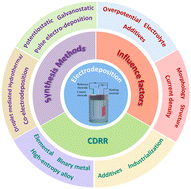Recent progress and prospect of electrodeposition-type catalysts in carbon dioxide reduction utilizations
Abstract
In recent years, electrocatalytic reduction of CO2 has been a focus in the research field. There are also various methods for synthesizing catalysts, such as the hydrothermal method, the arc method, electrospinning, etc. Here, we introduce the electrochemical deposition method. Compared with ordinary synthesis methods, electrodeposition has the advantages of simple processing, controllable conditions, high safety, and environmental friendliness. It is also a promising method for industrialized catalyst synthesis. In this review, we give a detailed introduction to electrodeposition, summarize the research progress of electrodeposition in the synthesis of catalysts, and discuss the key conditions in the preparation process, which are provided as a reference to synthesize next-generation electrodeposited electrocatalysts.

- This article is part of the themed collection: Recent Review Articles


 Please wait while we load your content...
Please wait while we load your content...